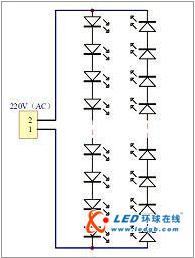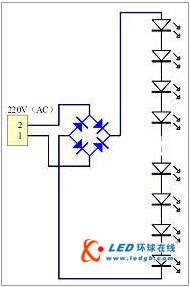1, AC LED
The single-crystal LED light-emitting chip has a driving voltage of 4V or less, and no matter how high the driving voltage can be connected in series, a suitable driving voltage can be obtained. This is an incomparable advantage of other light sources. CFLs require complex drive circuits, and LEDs can be matched by impedance in series with voltages that are different from mains. The length and diameter of the incandescent tungsten wire determine the resistance of the bulb and match the different drive voltages. The same is true for LEDs with different serial numbers, although LEDs are not purely resistive loads. Today we do not discuss how LEDs are most suitable for driving, focusing on the feasibility of AC and DC drives for the market.
The AC LED is a series of hundreds of single-die LEDs connected in series at the wafer level. It can be rectified and lit by the mains AC high voltage, and then connected in series with a resistor or constant current source to maintain the proper driving power range. Based on this design, it has been used on Christmas lights, and porting to LED die packaging is a mere feeling.
In order to be compatible with the voltage standards of various countries, it is divided into four parts in series, so that half of the value of 220V is exactly 110V, and the specifications are unified. AC LED is theoretically correct and feasible. The mains 50-60Hz single-string LED works in two positive and negative half-weeks. No matter how you design, it is generally the same.
LEDs are not resistive loads like incandescent lamps. Smaller voltage fluctuations can cause a large change in LED brightness and make it easier to see flicker. AC LEDs have certain requirements for AC voltage stability, because the volt-ampere characteristics of LEDs are steep, and 10% voltage changes can cause severe current fluctuations. For example, the forward voltage is changed from 3.3V to 3.6V, and the current is increased from 20mA to 34mA, which is increased by 70%. A sharp rise in current is fatal to the LED, and voltage drops do not damage the LED, and fluctuations in brightness can affect customer experience.

We see Figure 2, the high-voltage LED string is driven by DC, and the specific drive details are not analyzed for the time being. The AC uses bridge stack rectification, when the LED utilization rate is increased by 50%, and the number and cost of LEDs are also reduced by 50%. The rectifier bridge is inexpensive, and the process limitation integrated rectifier bridge is very uneconomical. The rectifier bridge is small in size and easy to accept in size. It is not economical to use AC to design LEDs directly.
Since the AC voltage is a sine wave, the current flowing through the LED is also a sine wave, and the utilization of the LED is not as high as that of the DC power. That is, the overall average light output is not as high as the same magnitude of direct current.
At first, Seoul Semiconductor designed an AC LED. Attentive friends will find that there is a rectifier bridge next to the LEDs on display. It is obvious that Seoul has realized the importance of cost. Taiwan Industrial Technology Research Institute and other companies have developed AC LED, but mass production is not so smooth, cost is an important factor, in principle, it is not feasible to be viable in the market.
